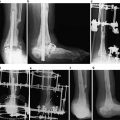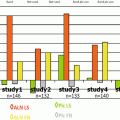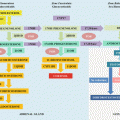Fig. 42.1
Illustration of main types of bariatric surgery currently being performed. By permission of Mayo Foundation for Medical Education and Research. All rights reserved
Roux-En-Y gastric bypass (RYGB) is currently the most common bariatric operation performed in the United States (Fig. 42.1c, d). In this procedure, the stomach is partitioned into a much larger distal portion and small (~15 ml) proximal portion, which receives food from esophagus. The proximal portion is then joined with the jejunum restricting the volume of a typical meal dramatically. The distal portion of the stomach, duodenum, and early jejunum are then connected downstream of the gastrojejunal anastomosis, thus bypassing this portion of intestine from receiving pancreatic enzymes and bile. The length of this bypassed portion of the jejunum or Roux limb can range from 75 cm to 250 cm to produce the desired amount of weight loss. Biliopancreatic diversion (BPD) performed with or without the duodenal switch (BPD-DS) are the main malabsorptive procedures being offered (Fig. 42.1e). These procedures include partitioning of the stomach in the case of BPD or creation of gastric sleeve as seen in BPD-DS. Then an anastomosis is formed between the stomach and the jejunum (BPD) or duodenum and jejunum (BPD-DS). Malabsorption of nutrients is then created when the biliopancreatic limb is joined to the distal small intestine, allowing only a short segment of “common channel” where digestive enzymes from pancreas and bile mix with food.
Impact of Bariatric Surgery on Type 2 Diabetes
Bariatric surgery is efficacious in producing weight loss. The Swedish Obese Subjects study compared outcome in 2010 patients who underwent bariatric surgery with a matched control group who received conventional treatment [14]. After 1–2 years, the RYGB group had lost 32 % of their body weight with the vertical banded gastroplasty (VBG) group losing 23 %, and the LAGB losing 20 % (Table 42.1). The conventional treatment group initially lost weight at 1 year but then regained by 2 years. After 10 years, the weight losses were 25 % for the RYGB, 17 % for VBG, and 15 % for LAGB. Although dropout was an issue, the long-term weight loss in the surgical group was considerably greater than conventional treatment group. A meta-analysis of 621 studies by Buchwald et al. revealed an average weight loss of 38.5 kg or 55.9 % of excess body weight loss for four distinct surgical procedures including BPD-DS [29]. The weight loss appeared to be sustained as studies with 2 or more years of follow-up revealed a mean total loss of 41.6 kg or 59 % of excess body weight loss. The results were more impressive in patients with diabetes with a mean total loss of 40.6 kg or 64.4 % of excess weight and loss of 42.9 kg or 58.0 % of excess weight in studies beyond 2 years.
Table 42.1
Percent weight loss with various interventions
6 months | 1 year | 2 years | 3 years | 4 years | 5 years | >5 years | |
|---|---|---|---|---|---|---|---|
Diet alone [49] | 5.0 | 4.6 | 4.4 | 3.0 | |||
Diet plus exercise [49] | 8.5 | 4.0 | 4.0 | 4.0 | 4.0 | ||
Meal replacements [49] | 9.6 | 7.5 | |||||
VLCD [49] | 16.0 | 10.0 | 5.0 | ||||
Orlistat [49] | 8.0 | 8.0 | 7.0 | 7.0 | 5.3 | ||
Lorcaserin 10 mg bid [24] | 5.0 | 4.5 | |||||
Phen/top 15 mg/92 mg [26] | 12.0 | 13.0 | 11.0 | ||||
LAGB [14] | 18.0 | 21.0 | 20.0 | 18.0 | 17.0 | 16.0 | 15.0 (10 years) |
VBG [14] | 23.0 | 26.0 | 23.0 | 21.0 | 20.0 | 18.0 | 17.0 (10 years) |
RYGB [14] | 27.0 | 33.0 | 32.0 | 30.0 | 29.0 | 27.0 | 25.0 (10 years) |
Equally impressive improvements in weight related medical comorbidities have been reported with bariatric surgery. Pories et al. first reported on the impact of bariatric surgery (RYGB) on type 2 diabetes and noted that 82.9 % of patients with non-insulin dependent diabetes (NIDDM) and 98.7 % of patients with glucose impairment experienced euglycemia without medications [30]. They also noted that 353 of the 608 patients (58.1 %) had hypertension prior to surgery and this rate was reduced to 14 % afterwards. Buchwald et al. in a meta-analysis also noted similarly impressive resolution of diabetes in 78.1 % overall and an improvement or resolution in 86.6 % [29]. Diabetes resolution was greatest for patients undergoing BPD-DS (95.1 % resolution rate) compared to 80.3 % with RYGB, and 56.7 % with LAGB. Hypertension resolved in 61.7 % of patients and resolved or improved in 78.5 % [31]. Obstructive sleep apnea was resolved in 85.7 % of patients and resolved or improved in 83.6 % [31]. Hyperlipidemia improved as well in greater than 70 % of patients [31]. Brethauer et al. conducted a similar meta-analysis for the gastric sleeve both as a staged and primary procedure [32]. They reported a weight loss of 60.4 % of excess weight in patients where gastric sleeve was the primary procedure and 46.9 % when it was used as a staged procedure. Seventy percent of patients with type 2 diabetes had an improvement or remission of their disease.
Mechanisms of Improvement in Diabetes
In addition to the improvement in insulin resistance produced by weight loss alone, additional mechanisms have been proposed to explain improvement and/or resolution of DMT2 after bariatric surgery. Kellum et al. first demonstrated the impact of gastric bypass on gastrointestinal hormones reporting a dramatic increase in enteroglucagon response to meal not observed after vertical banded gastroplasty [33]. Enteroglucagon corresponds to the protein product of the glucagon gene in the gut that generates many gut hormones (incretins) such as glucagon-like peptide 1 (GLP-1) and 2 (GLP-2), glucagon, glicentin, and oxyntomodulin [34]. Additional studies revealed that glucose-stimulated incretin levels increase after gastric bypass when they are typically blunted in T2DM [35–37]. Laferrère et al. revealed that this incretin effect can result in an increase in insulin secretion to levels seen in matched controls without T2DM only 1 month after gastric bypass [37]. This effect does not appear to be due to weight loss alone as shown in a study by Laferrère et al. that compared the change in incretin levels in obese women with T2DM undergoing RYGB versus their matched controls who lost an equivalent amount of weight with diet [38]. They found that GLP-1 levels after oral glucose increased sixfold after surgery, but not after diet. In fact, after diet induced weight loss, the levels of GLP-1 and GIP tended to decrease.
Additional beneficial changes in incretin secretion have been reported after bariatric surgery resulting in both central (hypothalamic appetite regulation) and peripheral (ileal break and delayed transport of nutrients through the gastrointestinal tract) mechanisms. Obese individuals typically have decreased basal and postprandial PYY [39] as well as decreased postprandial GLP-1 response [40], leading to lower feelings of satiety. This trend can be worsened with diet-induced weight loss as Sumithran et al. [41] revealed an increase in ghrelin and a reduction in peptide YY (PYY), amylin, and CCK leading to an increase in ratings of hunger, desire and urge to eat, as well as prospective consumption. The opposite has been reported after bariatric surgery [42–44]. One of the proposed mechanisms after gastric bypass is the increased delivery of unabsorbed nutrients to the GLP-1 and PYY producing L-Cells in the distal small bowel, resulting in amplified secretion of the incretins [45]. Others have speculated that there is a change in macronutrient composition after surgery that may result in alteration of incretin secretion. Evans et al. [45] investigated the mechanism of this change by comparing subjects who underwent RYGB with matched controls who were given a hypocaloric diet similar to a typical post-RYGB diet for 7 days. They provided the groups with a high protein or high fat meal. Gastric bypass resulted in augmented postprandial GLP-1 and PYY response to both meals. No augmentation in GLP-1 and minimal augmentation in PYY were seen in the low-calorie diet group. There was also a dramatic increase in hunger ratings in the diet group both before and after meal when compared to the RYGB group.
In addition to augmentation of GLP-1 and PYY secretion, bariatric surgery has also been noted to result in a change in ghrelin levels, a neuropeptide synthesized mainly in the antrum of the stomach that is known to have an orexigenic hypothalamic effect. Cummings et al. compared ghrelin levels before and after both a 6-month dietary program as well as gastric bypass [42]. They noted a significant rise in ghrelin levels in the dietary weight loss group. On the other hand, the gastric bypass subjects had markedly lower ghrelin levels compared to both the lean and obese controls, despite weight loss. They also did not have an oscillation in levels in relation to meals, an effect felt to be due to the process of over-ride inhibition that occurs when the stomach and duodenum are isolated from food. This tends to support patient subjective improvements in hunger and appetite regulation as exogenous ghrelin has been show to increase subjective hunger, food intake, as well as decrease catabolism of fat and metabolic rate, leading to increase in body weight.
These positive changes in incretin secretion are not only isolated to RYGB and have also been noted in patients undergoing gastric sleeve. Langer et al. prospectively compared ghrelin levels after gastric sleeve and LAGB and noted that they were dramatically reduced after the gastric sleeve and yet increased following LAGB. Peterli et al. [46] compared the change in ghrelin levels after a RYGB and gastric sleeve and observed a decrease in ghrelin levels within a few weeks of either procedure. The decrease was more prominent in the gastric sleeve group when compared to the RYGB group, a finding that can be explained by the fact that ghrelin producing cells are being removed in the gastric sleeve versus being isolated from nutrients in the RYGB. Gastric sleeve patients also had an improvement in GLP-1 response to meals that was less prominent than the RYGB group. This is a startling finding given the fact that the foregut is not being bypassed. One explanation for increased GLP-1 release may be that there is an additional trigger such as CCK for release of GLP-1 in addition to nutrient stimulation of L-cells. It also seems that despite the lack of bypass in gastric sleeve, accelerated gastric emptying and earlier contact of chyme with L cells may still be occurring. Scintigraphic studies have shown accelerated gastric emptying for solid and liquid foods up to 2 years after sleeve gastrectomy [47].
Stay updated, free articles. Join our Telegram channel

Full access? Get Clinical Tree






